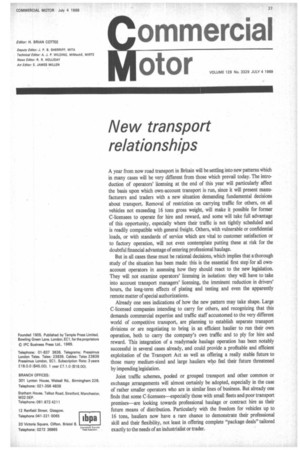New transport relationships
Page 29

If you've noticed an error in this article please click here to report it so we can fix it.
A year from now road transport in Britain will be settling into new patterns which in many cases will be very different from those which prevail today. The introduction of operators' licensing at the end of this year will particularly affect the basis upon which own-account transport is run, since it will present manufacturers and traders with a new situation demanding fundamental decisions about transport. Removal of restriction on carrying traffic for others, on all vehicles not exceeding 16 tons gross weight, will make it possible for former C-licensees to operate for hire and reward, and some will take full advantage of this opportunity, especially where their traffic is not tightly scheduled and is readily compatible with general freight. Others, with vulnerable or confidential loads, or with standards of service which are vital to customer satisfaction or to factory operation, will not even contemplate putting these at risk for the doubtful financial advantage of entering professional haulage.
But in all cases these must be rational decisions, which implies that a thorough study of the situation has been made: this is the essential first step for all ownaccount operators in assessing how they should react to the new legislation. They will not examine operators' licensing in isolation: they will have to take into account transport managers' licensing, the imminent reduction in drivers' hours, the long-term effects of plating and testing and even the apparently remote matter of special authorizations.
Already one sees indications of how the new pattern may take shape. Large C-licensed companies intending to carry for others, and recognizing that this demands commercial expertise and traffic staff accustomed to the very different world of competitive transport, are planning to establish separate transport divisions or are negotiating to bring in an efficient haulier to run their own operation, both to carry the company's own traffic and to ply for hire and reward. This integration of a readymade haulage operation has been notably successful in several cases already, and could provide a profitable and efficient exploitation of the Transport Act as well as offering a really stable future to those many medium-sized and large hauliers who feel their future threatened by impending legislation.
Joint traffic schemes, pooled or grouped transport and other common or exchange arrangements will almost certainly be adopted, especially in the case of rather smaller operators who are in similar lines of business. But already one finds that some C-licensees—especially those with small fleets and poor transport premises—are looking towards professional haulage or contract hire as their future means of distribution. Particularly with the freedom for vehicles up to 16 tons, hauliers now have a rare chance to demonstrate their professional skill and their flexibility, not least in offering complete "package deals" tailored exactly to the needs of an industrialist or trader.




























































































































































